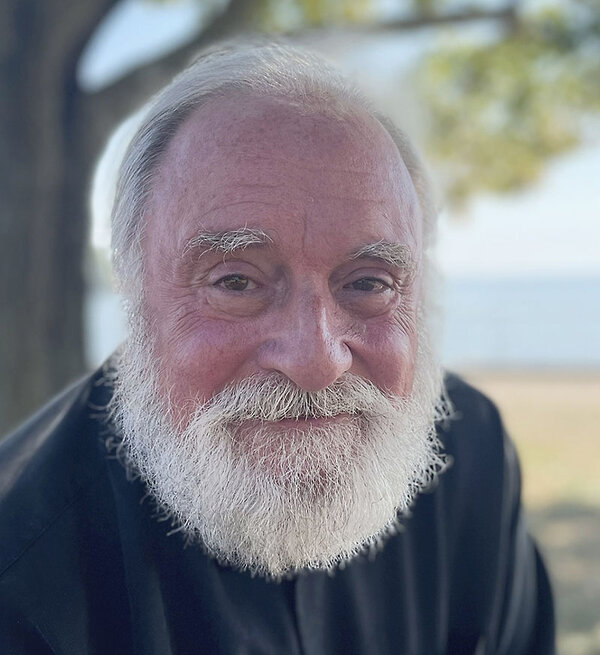How to have better conversations with people across the aisle
Loading...
How do we talk with those who hold views that are different from our own? What does real communication look like? These are questions that Bob Stains has thought about deeply over the decades. He’s trained tens of thousands of people in corporate, educational, and community settings how to work through conflicts.
Talking with people whose beliefs or lived experiences don’t mirror ours takes self-knowledge, kindness, and courage. The motivation to be “a repairer of the breach,” as Isaiah 58:12 describes it, also creates fertile ground in which the seeds of a richer, more honest dialogue can grow. And it helps to have tips from an expert. (Check out our book list for further reading on the topic.)
Mr. Stains starts from the premise that conflicts over identity, values, and worldview can’t be resolved. But they can be transformed. He spoke recently by video call with the Monitor. The interview has been edited and condensed.
Why We Wrote This
In a society riven by division, it can take courage to reach out to people who hold different views. We asked an expert on conflict transformation for tips.
How does looking into our own hearts unlock communication with others?
First, we have to ask ourselves, Are we really willing to go there? I use a lot of metaphors from Jewish and Christian Scriptures, and one I like is, “I will remove from you your heart of stone and give you a heart of flesh” [Ezekiel 36:26]. There’s a lot of advantages to hearts of stone. There are layers of protection. So the first question I have to ask is, How willing am I to soften my heart and let go of the protections that I’ve built around myself? And that can take a lot of work, right? Exploring how my heart has gotten stony with regard to particular people. So I do think that there is a piece of reflective practice that’s really helpful.
Many of us avoid conversations with people we see as difficult. How does asking questions and being curious help?
We’re often tempted to ask for what I call the simple story. We carry the simple story of the other person, and then we only ask things that confirm what we already believe.
Instead, we can find the good. There’s a story in Jewish tradition, which Rabbi David Jaffe writes about in his book “Changing the World From the Inside Out,” that all of us carry a shard of crystal that reflects the image of God in some way. So “finding the good” is about having the belief that the other person carries something of the image of God. And asking ourselves, How can I help bring that to the surface, see it, and honor it?
If we decide to engage with someone, how do we encourage a deeper connection?
A lot of times, people stay stuck on their particular perspective: “I believe and I think this way.” And they’ve maybe lost touch with the fact that it’s been a journey to get to where they are.
So when people reiterate their position, I might say, “I understand where you are on this issue.” Then I may ask if they are willing to talk further about how they got there. Have they always felt the same way and with the same passion? Can they take me upriver a little bit and help me understand who influenced them? When did their thinking change? And I think if we do that for ourselves, too, it helps us to see ourselves as more complex people, and we are seen as a more complex person who’s easier to connect to.
Cultural anthropologist Mary Catherine Bateson talked about the “continuity story” – which comes from the questions we could all predict: where you went to school, where you got a degree. But then there’s the “discontinuity story” represented by questions like, Who were the people and the turning points that shifted you in another direction? Once people get the feeling that you’re interested in more than just whatever the facade is, most are very willing to open up. And then some are willing to ask in return.
Let’s say you’ve hit a wall in a conversation. You can’t get any further. What do you do?
Well, [American educator] Parker Palmer says, “When the going gets rough, turn to wonder.” And that’s a good thing to live by. What he means is, can I be genuinely curious and interested in the experience or perspectives of another person, apart from the desire to impose mine on them?
I’ll give an example. I was talking recently with someone who clearly did not share my political or religious beliefs. We could have had a conversation that was just “I disagree with your perspective, and I think you’re very wrongheaded.” But I wanted to have a richer understanding of his story.
I teach an exercise I call “Standing in the River.” You imagine you’re standing in the river with somebody who disagrees with you, and you shift to a sincere inquiry about what is the river that the person is standing in and what are their values, commitments, concerns. And then looking upstream, where have those come from? And then looking downstream, what is the fruit that they imagine if these values are upheld? That’s where you start to get complexity and nuance and overlap, like the Venn diagram where you discover shared values that will then build a more shared conversation. I tried it with this man, and we had a good exchange.
How do we talk with friends and family members – who may be on the “same side” as we are politically, but who make disparaging comments about the other camp – if we’re trying to not perpetuate a climate of conflict and incivility?
It’s important to interrupt that kind of talk, if you can. But you want to do it in a way that doesn’t repeat the kind of righteousness that keeps us stuck in this problem. I don’t want to say, “Well, you’re stupid because you think they’re stupid.” That’s not going to do any good. But what I want to do is bear witness to complexity – the complexity of people on the other side, and the complexity of the people I’m listening to.
Here’s a scenario: An activist friend wants me to join a political demonstration. I have reservations – and I don’t want to contribute to further polarization. What do I say?
Each person will have a different response. I’ve marched against guns in Boston, and there are things that I will take on, but my general response when I’m asked is, I enjoy the camaraderie and the motivation it gives me to act. But I don’t want to be involved in creating more polarization. These kinds of events, to me, can be about defining others as evil. That’s not to say that’s always the case, or that you should never participate, never stand up for your beliefs by marching, or whatever you choose to do.
How can you tell when someone is willing to talk?
I think you have to be sensitive to the moment and where people want to go. And some people don’t really want to go there and that’s OK.
For the people who do want to go there, one of the phrases I keep in mind is: What else? What else are they wanting to say but haven’t been asked? And that’s the whole frame of asking all those other questions.







